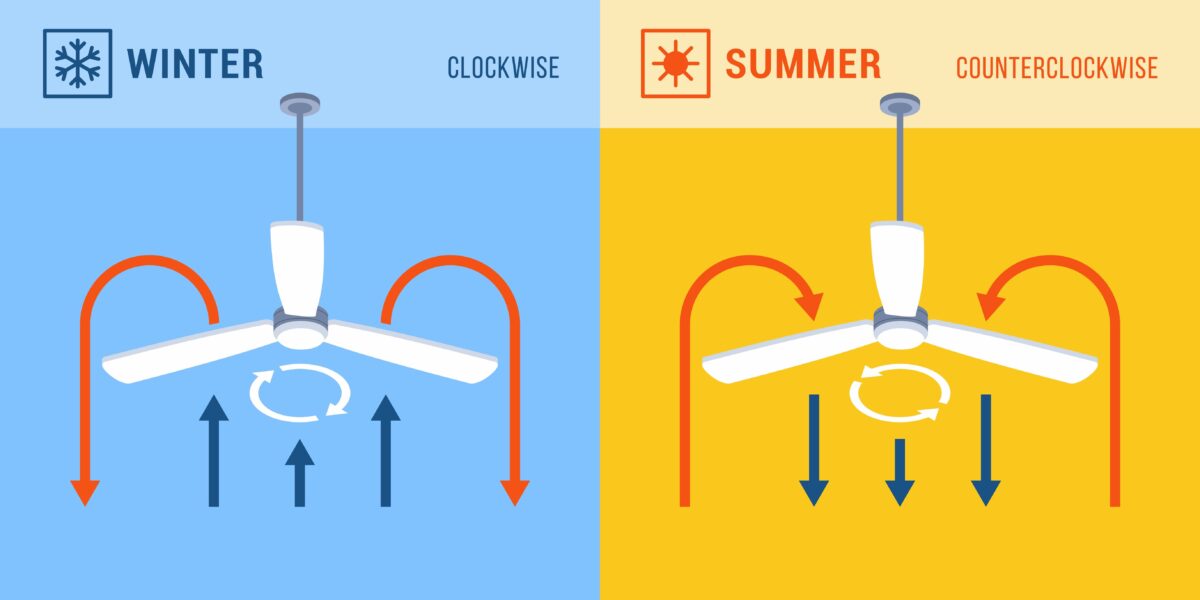Ceiling fan direction plays an important role in distributing the air in your home, saving you money on utility costs and reducing strain on your HVAC system. Learn more about which way a fan should spin and how to optimize its performance for summer and winter use.
How Ceiling Fans Create Ventilation
Your living spaces feel more comfortable with increased air movement, and using a ceiling fan is a great way to maintain a consistent temperature and alleviate problems like stagnant air.
Understanding Air Circulation
Air movement in your home affects everything from temperature to smell. Therefore, it’s essential to have good airflow to make your home feel as comfortable as possible.
The two most important factors in air circulation are ventilation and air distribution. Ventilation is how your home pulls in new, fresh air into your living space, replacing old stale air and making your home feel less stuffy.
Some types of ventilation in your home are intentional, such as vents and windows. Others are unintentional, like the air infiltration that happens when outside air leaks into your living space through the cracks around your door.
In combination with ventilation, air distribution is the other important factor in circulating air in your living spaces. This is where ceiling fans come into play. Ceiling fans distribute air using rotating blades, and depending on the direction the blades are spinning, they either pull air up or push it down into the living space.
Benefits of Improved Ventilation
Improved air distribution and ventilation in your home make it more comfortable by helping to regulate the temperature, remove odors, and improve air quality. The more ventilation you have, the less strain it puts on your HVAC system, which reduces energy costs.
Well-ventilated spaces make your home more comfortable by keeping you cooler in the summer and warmer in the winter. That’s why ceiling fans can help you create a healthier environment in your home by minimizing the risks of respiratory issues and dispersing unpleasant odors.
The Benefits of Using the Right Ceiling Fan Direction
Ceiling fans with reversible blades have a switch so you can change the direction of the fan blades, offering a versatile solution for year-round comfort. By adjusting the direction and speed of your ceiling fan, you can maximize the cooling effect and control the temperature in your living areas.
In the summer, set your ceiling fan to move counterclockwise. This creates a downdraft, which produces a cool breeze that aids the natural evaporative cooling of the human body.
In colder weather, set your ceiling fan to move clockwise so the fan blades will pull air upward and distribute it evenly throughout your living space.
Energy Efficiency
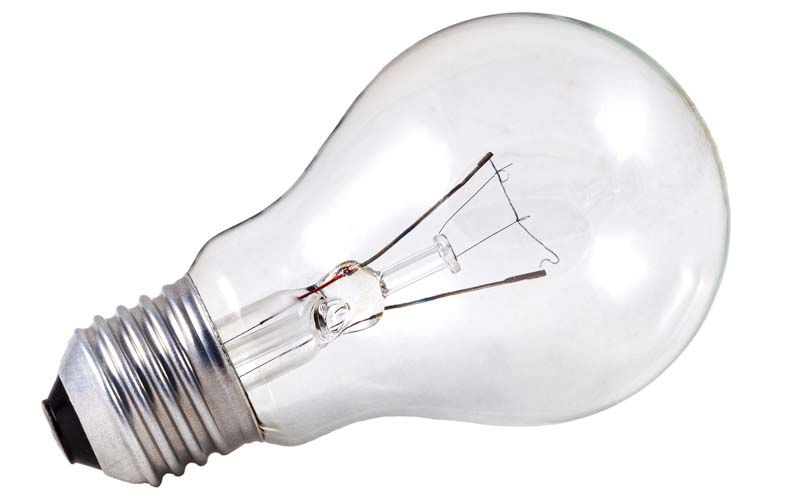
While ceiling fans don’t cool the air in the room, they create a wind-chill effect. When they’re going in the right direction, ceiling fans make you feel cooler rather than cooling the air temperature in the entire room.
Surprisingly, ceiling fans use about the same energy as a 100-watt lightbulb. Turning them off when you’re not in the room makes them more energy efficient. If you have a smart ceiling fan, turning it off is easy when you leave the room.
Comfort and Temperature Control
Just like ceiling fans don’t cool air, they also don’t heat it, but they can help you stay more comfortable and control the temperature in your living areas.
In the summer, your ceiling fan helps make the air in your living spaces feel cooler by moving air around. In the winter, ceiling fans distribute air and make the temperature more consistent, making you more comfortable.
Reduced Heating and Cooling Costs
The summer ceiling fan direction creates a downdraft, improving the ventilation in your home so it feels cooler. This means you can set your thermostat at a higher temperature during the summer to lower your utility bill.
In the winter, your HVAC system won’t have to work as hard to move air around and keep your home warm, which lowers your heating costs.
Reduced Strain on HVAC System
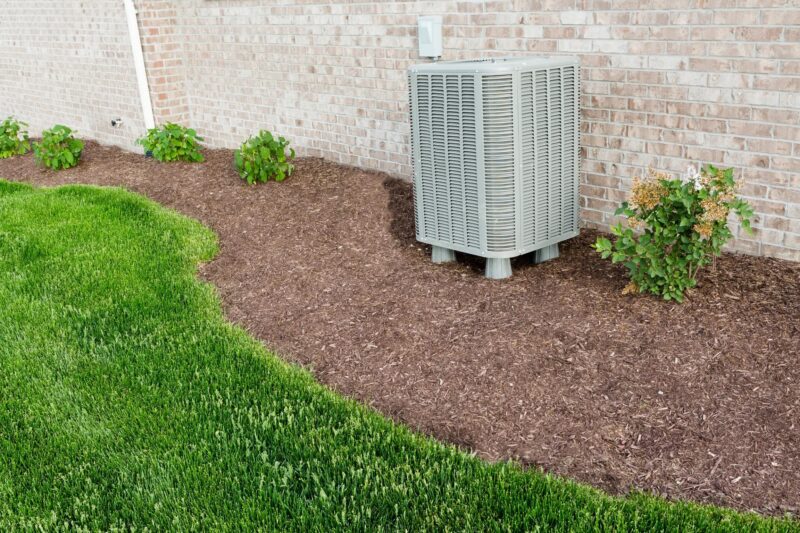
Since your HVAC system doesn’t have to work as hard to maintain a comfortable temperature in your home, there’s less strain on the components. This means you’ll have fewer breakdown and repair costs to deal with over the life of your system.
Environmental Advantages
Lowering energy consumption reduces your carbon footprint and lowers greenhouse emissions. It takes much less energy to run a ceiling fan than an AC unit, which is better for the environment.
Year-Round Use
Switching the ceiling fan rotation from summer to winter makes your ceiling fan suitable for year-round use. By changing the ceiling fan switch up or down, you can reverse the fan direction and use it during the summer and winter.
Customizable
Ceiling fans are versatile. You can change your fan clockwise or counterclockwise, from winter fan rotation to summer fan rotation, and you can also adjust the speed. This allows you to customize the settings depending on your personal preferences and how much air movement you want.
Explore how to wire a ceiling fan and light!
Ceiling Fan Direction in Summer vs. Winter
The summer fan setting makes your home seem cooler in the summer, while the winter fan setting helps distribute air for better heat distribution and more consistent temperatures. Learn more about how the different ceiling fan settings for summer and winter work.
Summer Ceiling Fan Direction (Counter-Clockwise)
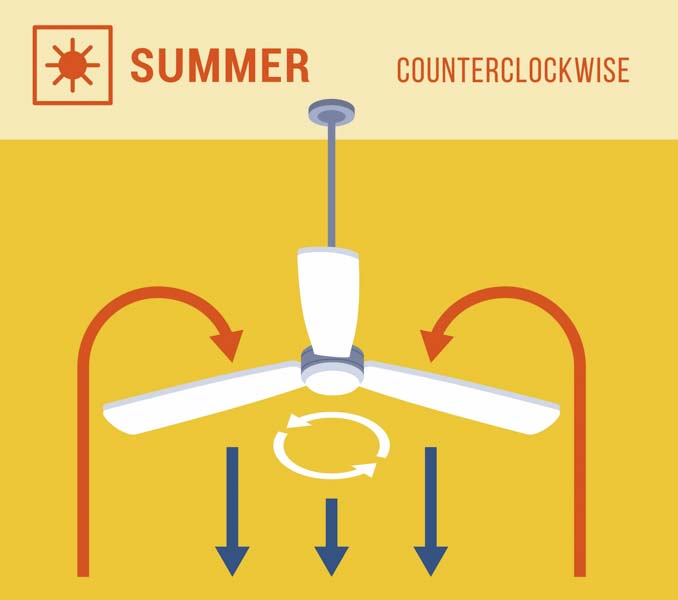
The proper ceiling fan direction for summer is counter-clockwise. This direction creates a downdraft that blows air on you while you’re in the room, making it feel colder by creating a wind-chill effect.
Winter Ceiling Fan Direction (Clockwise)
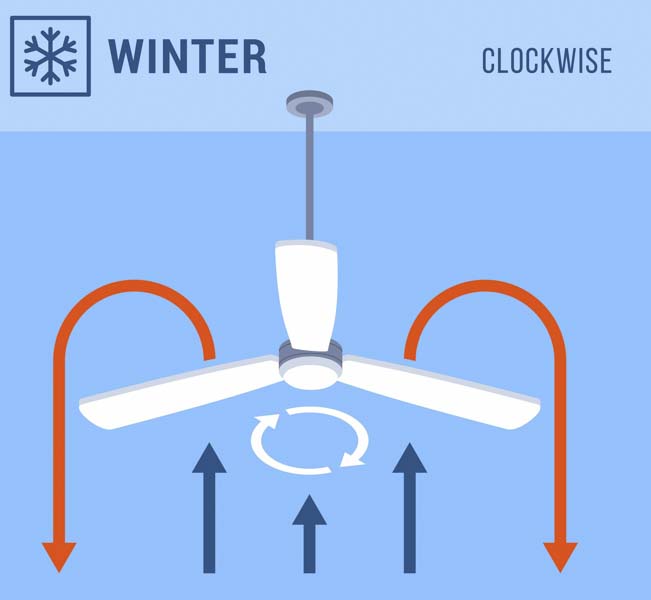
The best ceiling fan direction for winter is a clockwise direction. This pulls air up and distributes it throughout your living area. Air circulation is important during the colder months because it gets the heat off the floor, pushes it down from the ceiling, and keeps it in the middle of the room.
How to Tell Which Way Your Ceiling Fan is Going
If you’re wondering which way is clockwise on a ceiling fan, turn it to its lowest setting and stand underneath it. Looking up, imagine your ceiling fan as a clock face and notice which direction the fan blades are moving.
When the ceiling fans move clockwise to the right, it’s set for winter fan direction. They’re set for summer fan direction when they move counter-clockwise to the left.
When to Change the Direction of a Ceiling Fan
In addition to knowing which way a ceiling fan is supposed to spin, you also need to know when to change the direction and how to adjust the thermostat.
Seasonal Transition
The right time to change ceiling fan direction by season depends on your climate region. Depending on where you live, the best time to change your overhead fan direction varies.
A smart tip homeowners use is to add ceiling fan direction to their seasonal checklist for home maintenance. Switch to the winter fan direction when the temperature drops in the fall, and you’re doing other winterization chores. Change the fan circulation direction for cooling in the summertime as the weather gets nicer.
Thermostat Adjustments
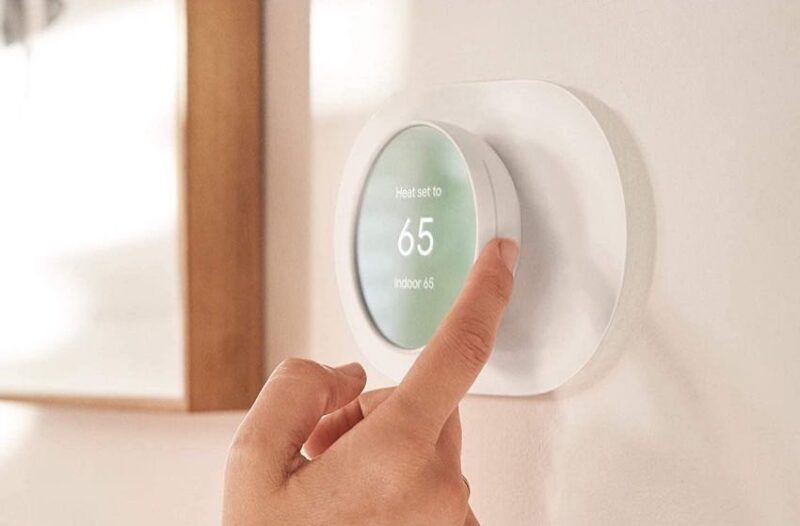
In the summer, with a counter-clockwise fan direction, you can save energy by lowering your thermostat setting. The windchill effect created by the downdraft of your ceiling fan makes the temperature in your living area seem about four degrees cooler.
To adjust your thermostat, turn the ceiling fan on to the highest speed setting, and turn your thermostat up one or two degrees at a time. Wait about an hour before adjusting it again.
Most homeowners set their thermostats between 70° and 75°F. For example, if you normally have yours set at 75°F, try setting it at 77° or 78°F.
Tips for Using Ceiling Fans and Changing Fan Blade Directions
Once you get the hang of it, ceiling fan direction is simple. Here are a few tips for purchasing and using ceiling fans.
Choosing the Right Ceiling Fan
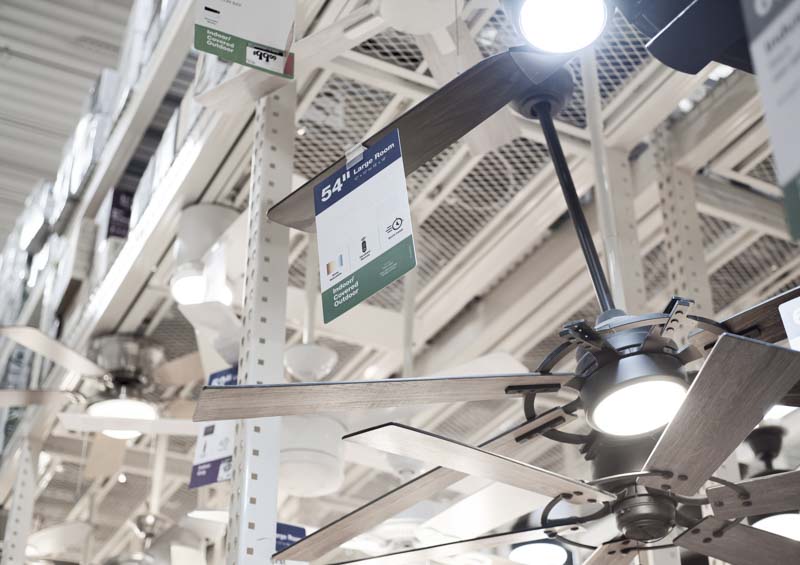
Ceiling fans don’t just move air around. They also enhance the appearance of your living space, and there are many sizes, designs, and colors to choose from.
One of the most important factors in choosing a ceiling fan is room size and the fan’s CFM (cubic feet per minute) rating, which tells you how much air it will move. Here are some additional factors to consider:
- Ceiling height
- Blade length
- Blade size and pitch
- Energy efficiency
- Style and design
- Control options
- Noise level
- Budget
Learn more about choosing the right ceiling fan!
Operating Ceiling Fans Effectively
Using your ceiling fan strategically with your heating and cooling systems helps maximize energy efficiency. No matter what type you have or where it’s located, seasonally changing the fan blade direction is the most effective way to operate your ceiling fan.
Ceiling fans don’t cool air, so keeping them running constantly doesn’t make sense. Turn the ceiling fan off to save energy when you’re not in the room.
Changing Fan Blade Direction
Almost all ceiling fans are reversible, and it’s easy to reverse the fan direction from summer to winter. The switch is usually located on the fan base, and all you have to do is flip it from one side to the other.
Additional Considerations of Ceiling Fan Directions
Here are some additional factors to consider regarding ceiling fans.
Ceiling Fan Size and Room Size
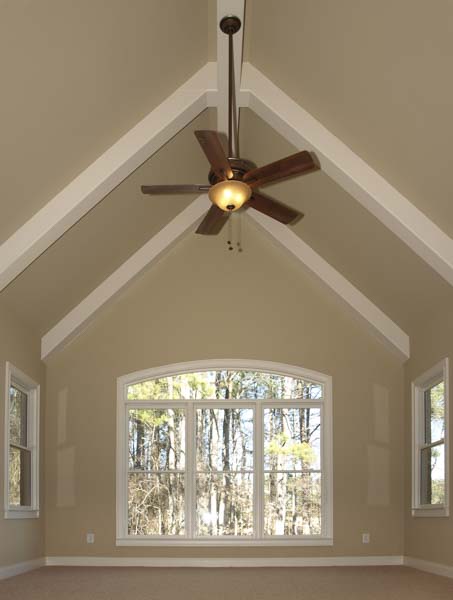
Ceiling fans should be sized properly to the room where they’re installed. The blade length is often used to determine the right size fan for your room.
| Ceiling fan blade length in inches | Best for |
| 29 to 36 | Rooms up to 75 square feet |
| 42 to 48 | Rooms up to 175 square feet |
| 52 to 56 | Rooms up to 350 square feet |
| 60 or more | Rooms larger than 350 square feet |
Ceiling Height and Blade Angle
The ceiling fan blade angle, or blade pitch, helps determine how much air is moved. It’s measured by comparing the angle of the blade to the floor. Ceiling fan blades are usually set at 12 degrees for maximum cooling. Anything over 16 degrees creates too much draft to be comfortable.
It’s harder to change the direction of ceiling fans installed on vaulted ceilings because they are out of easy reach. If the ceiling is tall enough, you don’t need to change the direction because it’s so far away that it won’t affect you.
Frequently Asked Questions (FAQs) about Ceiling Fan Direction
Which Way Should a Ceiling Fan Spin?
In the fall, you should change the direction your ceiling fan spins from the summer fan direction, which is counter-clockwise, to the clockwise winter fan direction. In the hotter months, you’ll enjoy the cooling effects of a downward draft, and in the winter, you’ll have more consistent temperatures in your living areas.
Which Way is Clockwise on My Ceiling Fan?
The easiest way to tell which way is clockwise on your ceiling fan is to set it at the lowest speed and stand beneath it. Imagine your ceiling fan is a clockface. If the blades are moving down to the right, your fan is going clockwise and set for winter.
Can I Use My Ceiling Fan All Year Round?
You can use your ceiling fan all year round, but unless it’s installed on a vaulted ceiling, you should change the direction seasonally. In the winter, turn your fan clockwise, and in the summer, turn it counterclockwise.
How Do I Change the Direction of My Ceiling Fan?
Almost all ceiling fans are reversible, so you can use them all year round. A switch on the ceiling fan base lets you change the direction the blades are spinning and better control the temperature in your living areas.
How Fast Should My Ceiling Fan Spin?
Not all ceiling fans are created equal. While almost all of them have variable speed settings, other factors influence how fast your ceiling fan spins, including the RPM (revolutions per minute) rating, the size of the motor, and the number of blades. You can set your ceiling fan to whatever speed makes you the most comfortable.

